Use of Graphene as a Biosensor
VerifiedAdded on 2023/01/16
|7
|1609
|96
AI Summary
This article explores the use of graphene as a biosensor and its applications in the medical field. It discusses the advantages of graphene-based biosensors in improving drug delivery, food safety, and biomolecule detection. The article also highlights the role of graphene in enhancing data collection and analysis.
Contribute Materials
Your contribution can guide someone’s learning journey. Share your
documents today.

Graphene Biosensor1
USE OF GRAPHENE AS A BIOSENSOR
By (Name)
Course
Tutor
Learning Institution
Date
USE OF GRAPHENE AS A BIOSENSOR
By (Name)
Course
Tutor
Learning Institution
Date
Secure Best Marks with AI Grader
Need help grading? Try our AI Grader for instant feedback on your assignments.
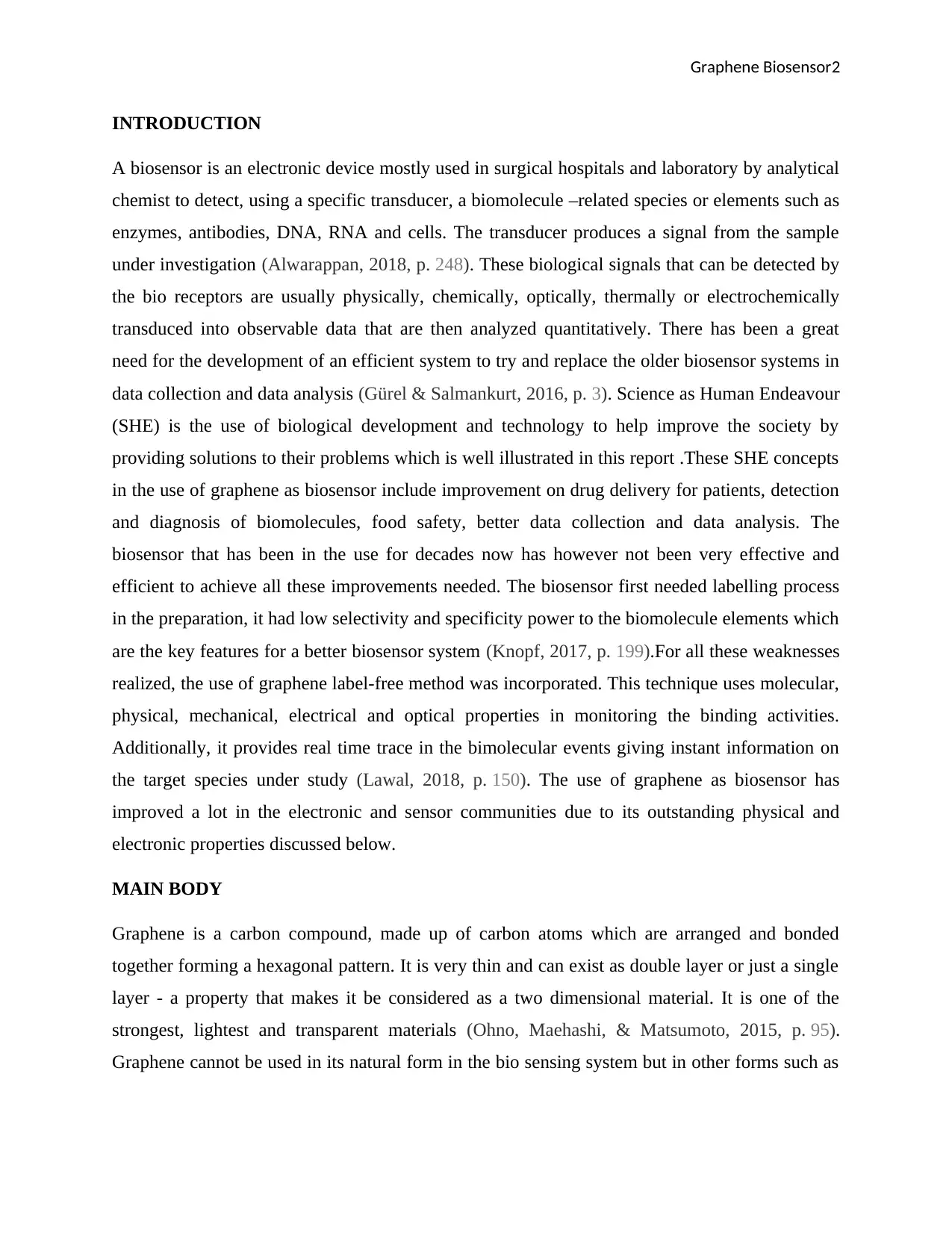
Graphene Biosensor2
INTRODUCTION
A biosensor is an electronic device mostly used in surgical hospitals and laboratory by analytical
chemist to detect, using a specific transducer, a biomolecule –related species or elements such as
enzymes, antibodies, DNA, RNA and cells. The transducer produces a signal from the sample
under investigation (Alwarappan, 2018, p. 248). These biological signals that can be detected by
the bio receptors are usually physically, chemically, optically, thermally or electrochemically
transduced into observable data that are then analyzed quantitatively. There has been a great
need for the development of an efficient system to try and replace the older biosensor systems in
data collection and data analysis (Gürel & Salmankurt, 2016, p. 3). Science as Human Endeavour
(SHE) is the use of biological development and technology to help improve the society by
providing solutions to their problems which is well illustrated in this report .These SHE concepts
in the use of graphene as biosensor include improvement on drug delivery for patients, detection
and diagnosis of biomolecules, food safety, better data collection and data analysis. The
biosensor that has been in the use for decades now has however not been very effective and
efficient to achieve all these improvements needed. The biosensor first needed labelling process
in the preparation, it had low selectivity and specificity power to the biomolecule elements which
are the key features for a better biosensor system (Knopf, 2017, p. 199).For all these weaknesses
realized, the use of graphene label-free method was incorporated. This technique uses molecular,
physical, mechanical, electrical and optical properties in monitoring the binding activities.
Additionally, it provides real time trace in the bimolecular events giving instant information on
the target species under study (Lawal, 2018, p. 150). The use of graphene as biosensor has
improved a lot in the electronic and sensor communities due to its outstanding physical and
electronic properties discussed below.
MAIN BODY
Graphene is a carbon compound, made up of carbon atoms which are arranged and bonded
together forming a hexagonal pattern. It is very thin and can exist as double layer or just a single
layer - a property that makes it be considered as a two dimensional material. It is one of the
strongest, lightest and transparent materials (Ohno, Maehashi, & Matsumoto, 2015, p. 95).
Graphene cannot be used in its natural form in the bio sensing system but in other forms such as
INTRODUCTION
A biosensor is an electronic device mostly used in surgical hospitals and laboratory by analytical
chemist to detect, using a specific transducer, a biomolecule –related species or elements such as
enzymes, antibodies, DNA, RNA and cells. The transducer produces a signal from the sample
under investigation (Alwarappan, 2018, p. 248). These biological signals that can be detected by
the bio receptors are usually physically, chemically, optically, thermally or electrochemically
transduced into observable data that are then analyzed quantitatively. There has been a great
need for the development of an efficient system to try and replace the older biosensor systems in
data collection and data analysis (Gürel & Salmankurt, 2016, p. 3). Science as Human Endeavour
(SHE) is the use of biological development and technology to help improve the society by
providing solutions to their problems which is well illustrated in this report .These SHE concepts
in the use of graphene as biosensor include improvement on drug delivery for patients, detection
and diagnosis of biomolecules, food safety, better data collection and data analysis. The
biosensor that has been in the use for decades now has however not been very effective and
efficient to achieve all these improvements needed. The biosensor first needed labelling process
in the preparation, it had low selectivity and specificity power to the biomolecule elements which
are the key features for a better biosensor system (Knopf, 2017, p. 199).For all these weaknesses
realized, the use of graphene label-free method was incorporated. This technique uses molecular,
physical, mechanical, electrical and optical properties in monitoring the binding activities.
Additionally, it provides real time trace in the bimolecular events giving instant information on
the target species under study (Lawal, 2018, p. 150). The use of graphene as biosensor has
improved a lot in the electronic and sensor communities due to its outstanding physical and
electronic properties discussed below.
MAIN BODY
Graphene is a carbon compound, made up of carbon atoms which are arranged and bonded
together forming a hexagonal pattern. It is very thin and can exist as double layer or just a single
layer - a property that makes it be considered as a two dimensional material. It is one of the
strongest, lightest and transparent materials (Ohno, Maehashi, & Matsumoto, 2015, p. 95).
Graphene cannot be used in its natural form in the bio sensing system but in other forms such as
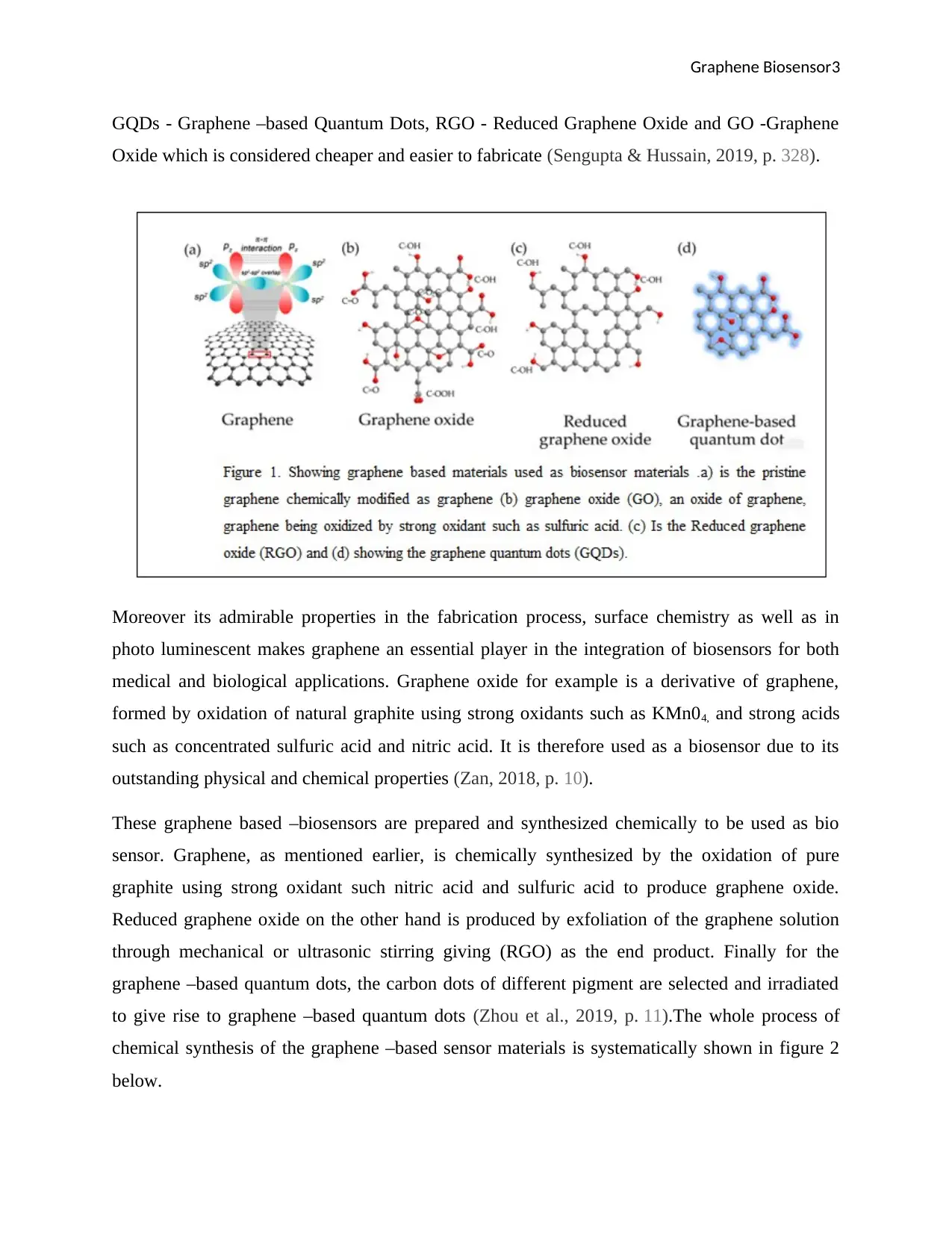
Graphene Biosensor3
GQDs - Graphene –based Quantum Dots, RGO - Reduced Graphene Oxide and GO -Graphene
Oxide which is considered cheaper and easier to fabricate (Sengupta & Hussain, 2019, p. 328).
Moreover its admirable properties in the fabrication process, surface chemistry as well as in
photo luminescent makes graphene an essential player in the integration of biosensors for both
medical and biological applications. Graphene oxide for example is a derivative of graphene,
formed by oxidation of natural graphite using strong oxidants such as KMn04, and strong acids
such as concentrated sulfuric acid and nitric acid. It is therefore used as a biosensor due to its
outstanding physical and chemical properties (Zan, 2018, p. 10).
These graphene based –biosensors are prepared and synthesized chemically to be used as bio
sensor. Graphene, as mentioned earlier, is chemically synthesized by the oxidation of pure
graphite using strong oxidant such nitric acid and sulfuric acid to produce graphene oxide.
Reduced graphene oxide on the other hand is produced by exfoliation of the graphene solution
through mechanical or ultrasonic stirring giving (RGO) as the end product. Finally for the
graphene –based quantum dots, the carbon dots of different pigment are selected and irradiated
to give rise to graphene –based quantum dots (Zhou et al., 2019, p. 11).The whole process of
chemical synthesis of the graphene –based sensor materials is systematically shown in figure 2
below.
GQDs - Graphene –based Quantum Dots, RGO - Reduced Graphene Oxide and GO -Graphene
Oxide which is considered cheaper and easier to fabricate (Sengupta & Hussain, 2019, p. 328).
Moreover its admirable properties in the fabrication process, surface chemistry as well as in
photo luminescent makes graphene an essential player in the integration of biosensors for both
medical and biological applications. Graphene oxide for example is a derivative of graphene,
formed by oxidation of natural graphite using strong oxidants such as KMn04, and strong acids
such as concentrated sulfuric acid and nitric acid. It is therefore used as a biosensor due to its
outstanding physical and chemical properties (Zan, 2018, p. 10).
These graphene based –biosensors are prepared and synthesized chemically to be used as bio
sensor. Graphene, as mentioned earlier, is chemically synthesized by the oxidation of pure
graphite using strong oxidant such nitric acid and sulfuric acid to produce graphene oxide.
Reduced graphene oxide on the other hand is produced by exfoliation of the graphene solution
through mechanical or ultrasonic stirring giving (RGO) as the end product. Finally for the
graphene –based quantum dots, the carbon dots of different pigment are selected and irradiated
to give rise to graphene –based quantum dots (Zhou et al., 2019, p. 11).The whole process of
chemical synthesis of the graphene –based sensor materials is systematically shown in figure 2
below.

Graphene Biosensor4
The application of the graphene – based materials in the bio sensing system takes place in two
broad ways .One involves the charge –biomolecule interacting at the π-π bonds between the
charge exchange and the electrostatic forces causing variations that are electrical in nature at the
surface of the graphene based sensors .The other way involves chemical functionalization, use of
disorder and defects to immobilize on the surfaces of the sensors (Zan, 2018, p. 10).
Graphene, because of its charges which are highly mobile, possess admirable electronic
properties. Engineers use it as receptor for targeting biomolecule elements due to its wide surface
area hence ability to functionalize on its surface (Ohno, Maehashi, & Matsumoto, 2015, p. 98). It
offers a large surface area at the molecular level in the bio-sensing process. This increases the
number of active sites which it provides for the interactions between the charges and the
biomolecules. This overally leads to sensing enhancement thus improving the selectivity of the
biosensor as shown in the figure 3 below.
The application of the graphene – based materials in the bio sensing system takes place in two
broad ways .One involves the charge –biomolecule interacting at the π-π bonds between the
charge exchange and the electrostatic forces causing variations that are electrical in nature at the
surface of the graphene based sensors .The other way involves chemical functionalization, use of
disorder and defects to immobilize on the surfaces of the sensors (Zan, 2018, p. 10).
Graphene, because of its charges which are highly mobile, possess admirable electronic
properties. Engineers use it as receptor for targeting biomolecule elements due to its wide surface
area hence ability to functionalize on its surface (Ohno, Maehashi, & Matsumoto, 2015, p. 98). It
offers a large surface area at the molecular level in the bio-sensing process. This increases the
number of active sites which it provides for the interactions between the charges and the
biomolecules. This overally leads to sensing enhancement thus improving the selectivity of the
biosensor as shown in the figure 3 below.
Secure Best Marks with AI Grader
Need help grading? Try our AI Grader for instant feedback on your assignments.
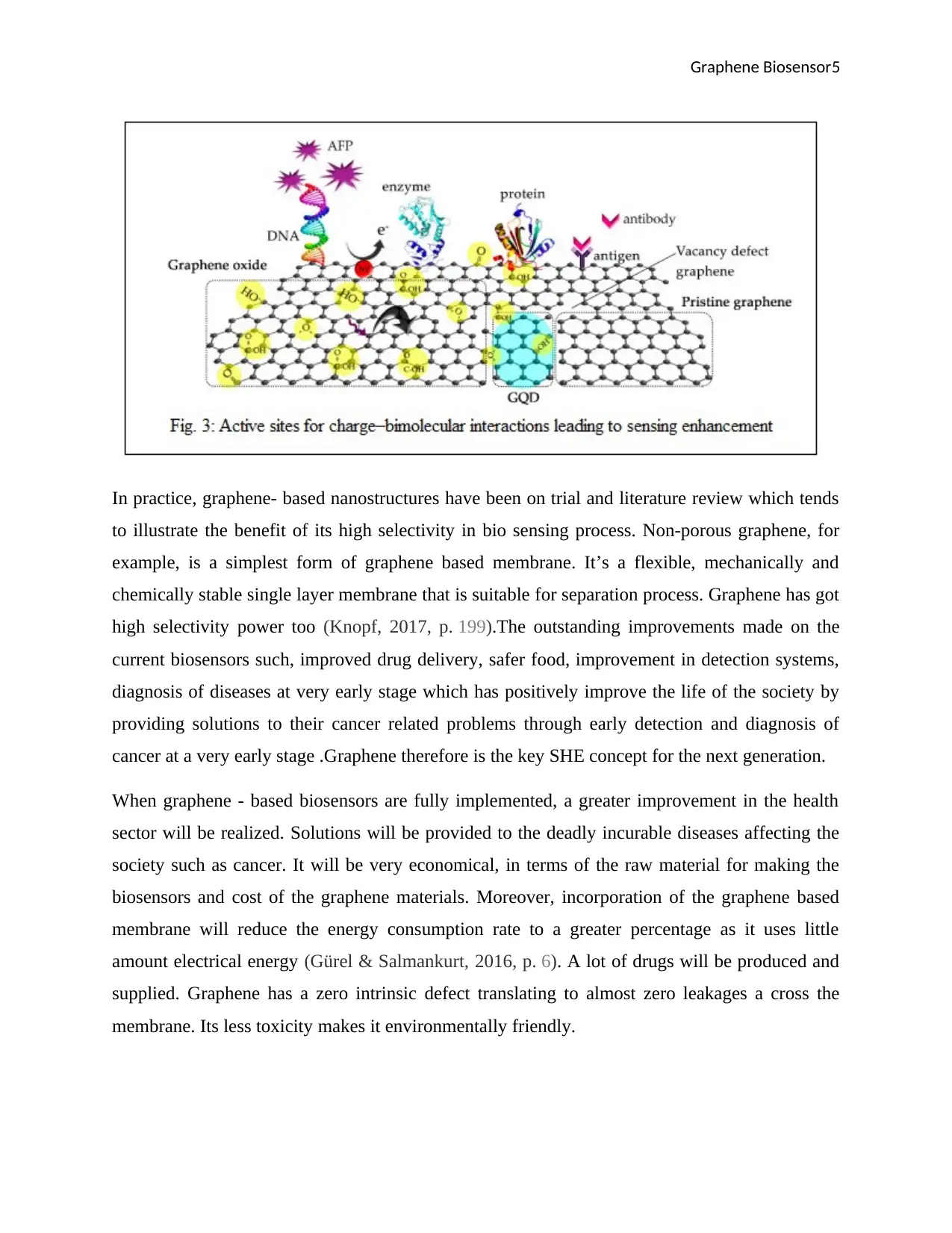
Graphene Biosensor5
In practice, graphene- based nanostructures have been on trial and literature review which tends
to illustrate the benefit of its high selectivity in bio sensing process. Non-porous graphene, for
example, is a simplest form of graphene based membrane. It’s a flexible, mechanically and
chemically stable single layer membrane that is suitable for separation process. Graphene has got
high selectivity power too (Knopf, 2017, p. 199).The outstanding improvements made on the
current biosensors such, improved drug delivery, safer food, improvement in detection systems,
diagnosis of diseases at very early stage which has positively improve the life of the society by
providing solutions to their cancer related problems through early detection and diagnosis of
cancer at a very early stage .Graphene therefore is the key SHE concept for the next generation.
When graphene - based biosensors are fully implemented, a greater improvement in the health
sector will be realized. Solutions will be provided to the deadly incurable diseases affecting the
society such as cancer. It will be very economical, in terms of the raw material for making the
biosensors and cost of the graphene materials. Moreover, incorporation of the graphene based
membrane will reduce the energy consumption rate to a greater percentage as it uses little
amount electrical energy (Gürel & Salmankurt, 2016, p. 6). A lot of drugs will be produced and
supplied. Graphene has a zero intrinsic defect translating to almost zero leakages a cross the
membrane. Its less toxicity makes it environmentally friendly.
In practice, graphene- based nanostructures have been on trial and literature review which tends
to illustrate the benefit of its high selectivity in bio sensing process. Non-porous graphene, for
example, is a simplest form of graphene based membrane. It’s a flexible, mechanically and
chemically stable single layer membrane that is suitable for separation process. Graphene has got
high selectivity power too (Knopf, 2017, p. 199).The outstanding improvements made on the
current biosensors such, improved drug delivery, safer food, improvement in detection systems,
diagnosis of diseases at very early stage which has positively improve the life of the society by
providing solutions to their cancer related problems through early detection and diagnosis of
cancer at a very early stage .Graphene therefore is the key SHE concept for the next generation.
When graphene - based biosensors are fully implemented, a greater improvement in the health
sector will be realized. Solutions will be provided to the deadly incurable diseases affecting the
society such as cancer. It will be very economical, in terms of the raw material for making the
biosensors and cost of the graphene materials. Moreover, incorporation of the graphene based
membrane will reduce the energy consumption rate to a greater percentage as it uses little
amount electrical energy (Gürel & Salmankurt, 2016, p. 6). A lot of drugs will be produced and
supplied. Graphene has a zero intrinsic defect translating to almost zero leakages a cross the
membrane. Its less toxicity makes it environmentally friendly.
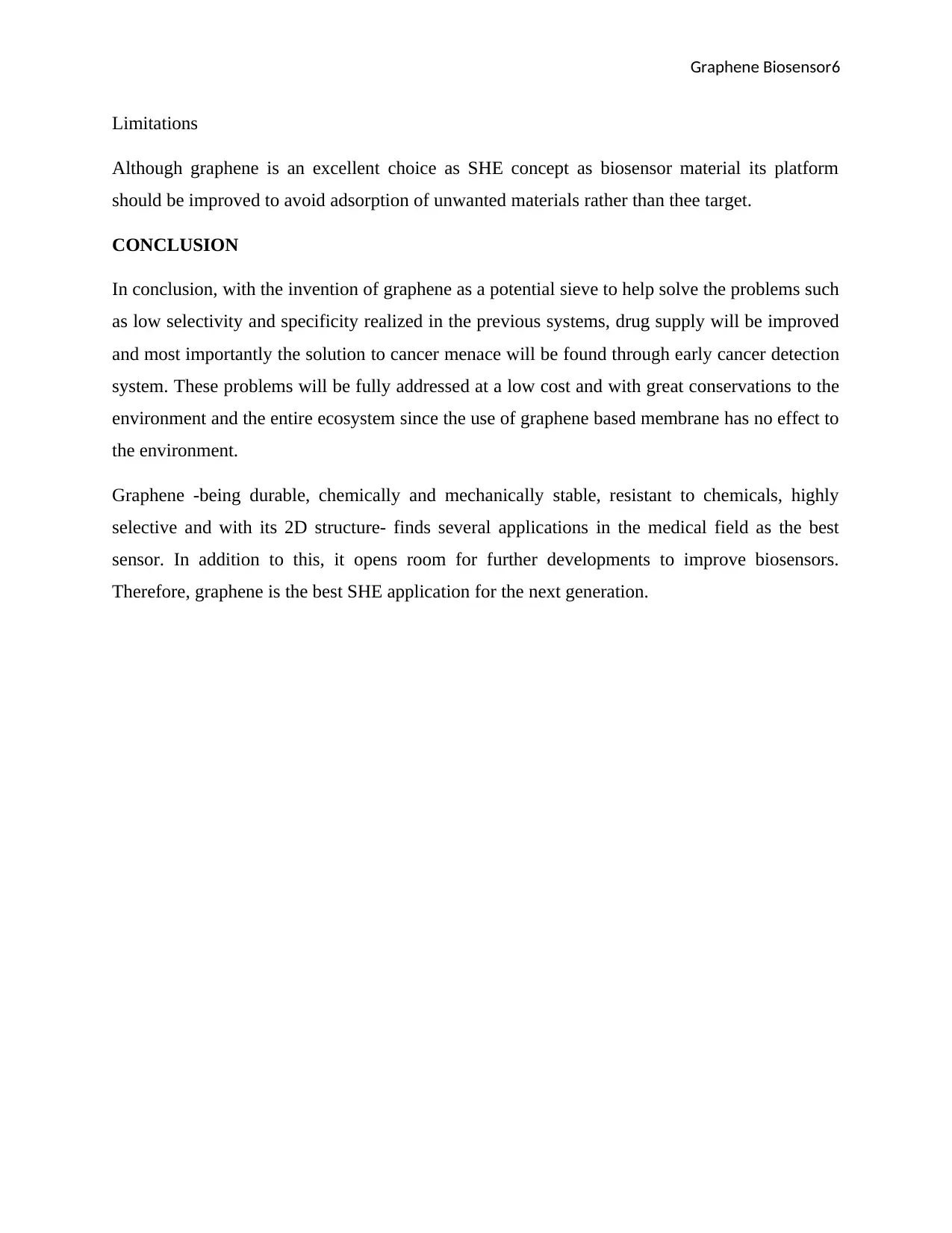
Graphene Biosensor6
Limitations
Although graphene is an excellent choice as SHE concept as biosensor material its platform
should be improved to avoid adsorption of unwanted materials rather than thee target.
CONCLUSION
In conclusion, with the invention of graphene as a potential sieve to help solve the problems such
as low selectivity and specificity realized in the previous systems, drug supply will be improved
and most importantly the solution to cancer menace will be found through early cancer detection
system. These problems will be fully addressed at a low cost and with great conservations to the
environment and the entire ecosystem since the use of graphene based membrane has no effect to
the environment.
Graphene -being durable, chemically and mechanically stable, resistant to chemicals, highly
selective and with its 2D structure- finds several applications in the medical field as the best
sensor. In addition to this, it opens room for further developments to improve biosensors.
Therefore, graphene is the best SHE application for the next generation.
Limitations
Although graphene is an excellent choice as SHE concept as biosensor material its platform
should be improved to avoid adsorption of unwanted materials rather than thee target.
CONCLUSION
In conclusion, with the invention of graphene as a potential sieve to help solve the problems such
as low selectivity and specificity realized in the previous systems, drug supply will be improved
and most importantly the solution to cancer menace will be found through early cancer detection
system. These problems will be fully addressed at a low cost and with great conservations to the
environment and the entire ecosystem since the use of graphene based membrane has no effect to
the environment.
Graphene -being durable, chemically and mechanically stable, resistant to chemicals, highly
selective and with its 2D structure- finds several applications in the medical field as the best
sensor. In addition to this, it opens room for further developments to improve biosensors.
Therefore, graphene is the best SHE application for the next generation.
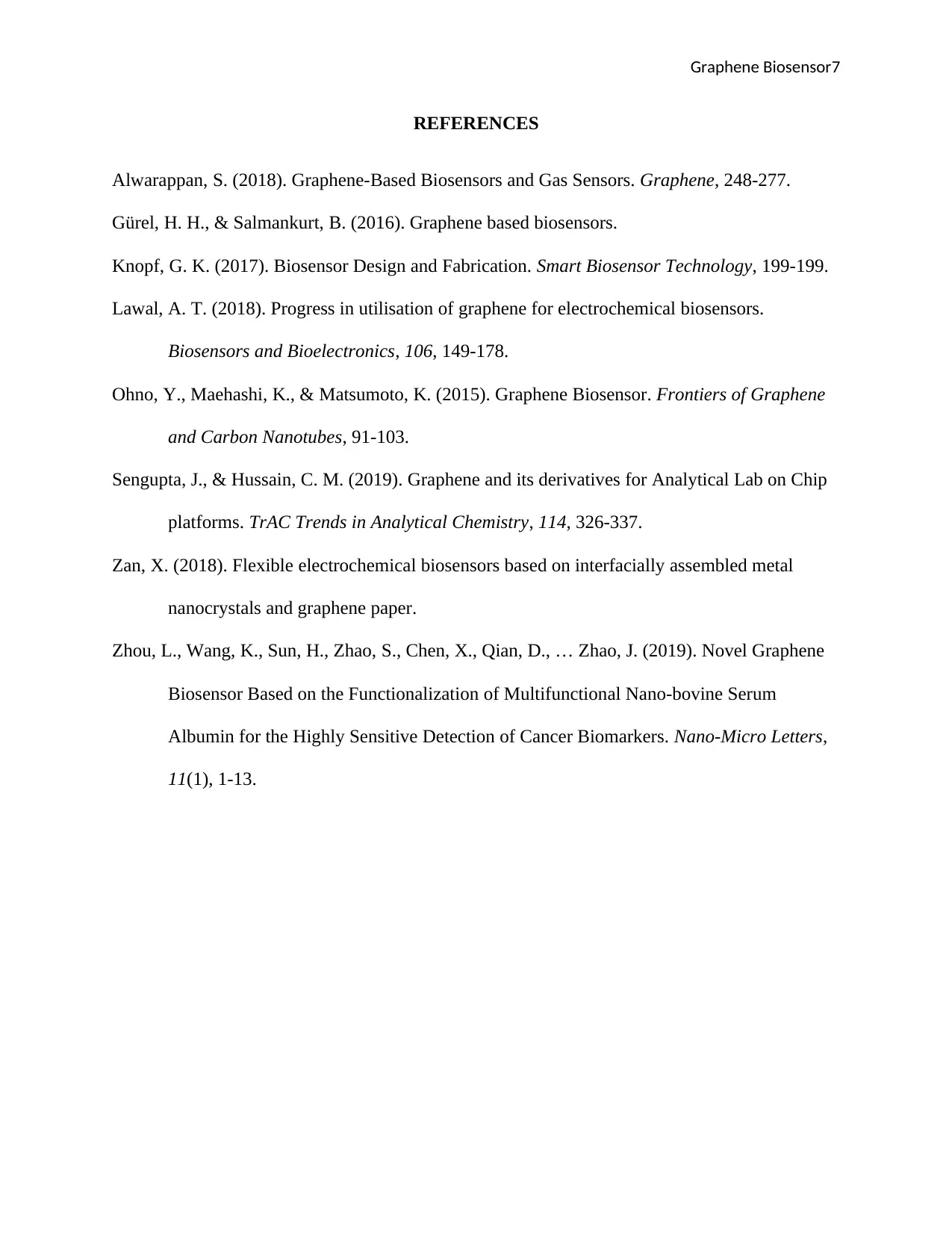
Graphene Biosensor7
REFERENCES
Alwarappan, S. (2018). Graphene-Based Biosensors and Gas Sensors. Graphene, 248-277.
Gürel, H. H., & Salmankurt, B. (2016). Graphene based biosensors.
Knopf, G. K. (2017). Biosensor Design and Fabrication. Smart Biosensor Technology, 199-199.
Lawal, A. T. (2018). Progress in utilisation of graphene for electrochemical biosensors.
Biosensors and Bioelectronics, 106, 149-178.
Ohno, Y., Maehashi, K., & Matsumoto, K. (2015). Graphene Biosensor. Frontiers of Graphene
and Carbon Nanotubes, 91-103.
Sengupta, J., & Hussain, C. M. (2019). Graphene and its derivatives for Analytical Lab on Chip
platforms. TrAC Trends in Analytical Chemistry, 114, 326-337.
Zan, X. (2018). Flexible electrochemical biosensors based on interfacially assembled metal
nanocrystals and graphene paper.
Zhou, L., Wang, K., Sun, H., Zhao, S., Chen, X., Qian, D., … Zhao, J. (2019). Novel Graphene
Biosensor Based on the Functionalization of Multifunctional Nano-bovine Serum
Albumin for the Highly Sensitive Detection of Cancer Biomarkers. Nano-Micro Letters,
11(1), 1-13.
REFERENCES
Alwarappan, S. (2018). Graphene-Based Biosensors and Gas Sensors. Graphene, 248-277.
Gürel, H. H., & Salmankurt, B. (2016). Graphene based biosensors.
Knopf, G. K. (2017). Biosensor Design and Fabrication. Smart Biosensor Technology, 199-199.
Lawal, A. T. (2018). Progress in utilisation of graphene for electrochemical biosensors.
Biosensors and Bioelectronics, 106, 149-178.
Ohno, Y., Maehashi, K., & Matsumoto, K. (2015). Graphene Biosensor. Frontiers of Graphene
and Carbon Nanotubes, 91-103.
Sengupta, J., & Hussain, C. M. (2019). Graphene and its derivatives for Analytical Lab on Chip
platforms. TrAC Trends in Analytical Chemistry, 114, 326-337.
Zan, X. (2018). Flexible electrochemical biosensors based on interfacially assembled metal
nanocrystals and graphene paper.
Zhou, L., Wang, K., Sun, H., Zhao, S., Chen, X., Qian, D., … Zhao, J. (2019). Novel Graphene
Biosensor Based on the Functionalization of Multifunctional Nano-bovine Serum
Albumin for the Highly Sensitive Detection of Cancer Biomarkers. Nano-Micro Letters,
11(1), 1-13.
1 out of 7
Your All-in-One AI-Powered Toolkit for Academic Success.
+13062052269
info@desklib.com
Available 24*7 on WhatsApp / Email
![[object Object]](/_next/static/media/star-bottom.7253800d.svg)
Unlock your academic potential
© 2024 | Zucol Services PVT LTD | All rights reserved.


